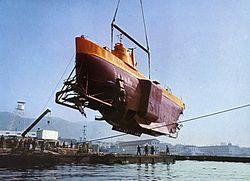Archimède
|
The Archimède 1961
|
||||||||||||
|
||||||||||||
|
||||||||||||
|
||||||||||||
|
||||||||||||
The Archimède is a bathyscaphe built in France in 1961 . It is named after the Greek philosopher and scientist Archimedes , who discovered the Archimedean principle .
history
The French Navy began planning to build the vehicle, the fourth bathyscaphe worldwide, in 1955. The project was managed by Pierre Willm and the naval officer Georges Houot , who also incorporated experience with the FNRS-3 that had been tested the previous year . The project was funded by the French CNRS and the Belgian FNRS . Construction began in 1961 at the Toulon arsenal and was completed after being launched on July 28 of that year. Testing in the Mediterranean also began in 1961, reaching depths of up to 2,300 m.
In April 1962, the Archimède was transported by cargo plane to Japan , where the boat carried out expeditions into the Kuril Trench in the following months . A depth of 9,545 m was reached on July 25, 1962, the second largest depth at that time after the record dive of the Trieste in October 1960.
In the years that followed, the Archimède made further dives around the world. Among other things, the Puerto Rico Trench ( United States ; 8,300 m) was dived in 1964, and the Mediterranean at Cape Matapan ( Greece , 5,110 m) in 1965 . In 1966 the boat dived off Madeira up to 4,390 m. In 1967 another expedition was undertaken into the Kuril Trench; 9,260 m were reached. On all these dives, the Archimède carried out research in the scientific disciplines of biology , geology and geophysics .
In 1968 the boat took part in the search for the French submarine Minerve , which sank off Toulon . When the Eurydice sank two years later , the Archimède was also involved in the search. In 1970 she also played a decisive role in the recovery of the submersible Cyana, which sank to a depth of 3,400 m during an unmanned test dive . Here, the Archimède separated the emergency ballast of the boat with its gripper arm, which could then reappear independently. The bathyscaphe later took part in scientific expeditions again, including the French-American Mid-Ocean Undersea Study project (FAMOUS) on the Mid-Atlantic Ridge , accompanied by other submersibles such as Alvin (DSV-2) and the already mentioned Cyana .
In all of these ventures, the boat was looked after by its mother ship, the Marcel Le Bihan - the former air traffic control ship Greif of the German Air Force .
In 1974 the boat was decommissioned and kept in the Naval Arsenal of Cherbourg . In 2001 the Archimède became the property of the Cherbourger Naval Museum La Cité de la Mer and has been exhibited there ever since.
construction
Unlike previous bathyscaphe like Trieste has buoyancy of Archimède completely ship shape. This principle had already been used in the FNRS-3 and has now been perfected. Even the actual spherical pressure hull was integrated into the float. The background to this construction was the requirement of the navy to be able to tow the bathyscaphe on the surface with 8 knots. This was hardly possible with the Trieste or the FNRS-2 , the first bathyscaph ever; the latter ship was even heavily damaged on the surface when towed in a storm in 1948, which shows the inadequate seaworthiness of the float at the time.
In this way it was also possible to move the bathyscaph not only vertically but also horizontally during the dives: During an expedition in 1973, for example, the Archimède covered a distance of 9 km on the seabed at a depth of 2,680 m in search of rock samples. This was also a clear step forward.
The dimensions of the float included a length of 22.1 m, a maximum width of 5 m and a total height of 9.1 m. It held 112.9 t or 170 cubic meters of gasoline as a buoyancy liquid, and the ship also carried 57.50 t of ballast.
The pressure hull, on the other hand, was made more conservative again. It consisted of steel walls alloyed with chrome , nickel and molybdenum , which were no more than 15 cm thick. The inside of the entire sphere had a diameter of 2.10 m and weighed 19 t. Theoretically, this ball would have withstood a load up to a depth of 30,000 m.
In addition, the Archimède could carry a payload of up to 2.7 t u. a. transport in the form of scientific equipment. A manipulator was also part of the ship's fixed equipment. The crew consisted of a pilot and two other people.
gallery
The Archimède at the christening next to her predecessor FNRS-3
See also
literature
- Georges Houot , 20 ans de bathyscaphe , Éditions Arthaud, Paris, 1972 (French)
- Riffaud, Claude / LePichon, Xaxier : Expedition "Famous". 3000 meters below the Atlantic , Kiepenheuer & Witsch Verlag, Cologne 1977, ISBN 978-3-59-623521-6 .
- Cloud, Wallaceː Jeeps in the Deepː Exploring Innerspace at 4,500 Fathoms , Popular Science, August 1964, Google Books Scan of the edition article about Archiméde Tauchgang pp. 42–46 and p. 180
Web links
- Overview of the Archimède and its missions (French)
- The Archimède on the side of the Cité de la Mer (French)
- Le Marcel Le Bihan A 759 (French)
- La tragédie de la Minerve (French)
Coordinates: 49 ° 38 '46.6 " N , 1 ° 37' 2.9" W.








